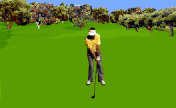By Jack Moorehouse
Greens hit in regulation (GIR), as we’ve said in our golf tips newsletters, is a critical statistic in golf. GIR measures how often you hit greens with your approach shots, setting you up for a birdie putt. The more greens hit in regulation, the lower your scores. Hitting accurate approach shots is a must if you want to score well and cut your golf handicap. Obviously, you’ll need to put in some work perfecting your iron shots if you’re a poor iron player.
But even with hard work, you’ll still occasionally miss approach shots. If you end up in no man’s land—40 yards or less from the green—you’re often faced with a critical decision on what to do next. With courses becoming longer and longer, you may find yourself facing this decision more and more. Two shots that can help make that decision easier are the bump-and-run and the putt-chip. These shots are often taught in golf instruction sessions because of their stroke-saving capabilities.
CB Advertisement
The Bump-And Run
The bump and run is easy to hit. All you need do is follow some simple rules. The first is: select a good landing spot. A general rule of thumb cited in golf lessons is to fly the ball about two-thirds of the way to the hole, then let it run the final third. When you pick your spot, which is usually short of the green, figure on a lower trajectory. Next, set up for a low shot. Narrow your stance with your front foot slightly open, play the ball back of center, and set your hands off the inside of your front thigh.
Once set up, take a short backswing. With a 9-iron all you need to do is take your arms back to waist high with just a touch of wrist hinge. This gives you about 25 yards of carry and 15 of roll. If you need to hit it farther, use an 8-iron. For shorter shots, use a pitching wedge. Your backswing length controls the shot’s distance so there’s no need to adjust your through swing. Also, turn through the shot just as you would normally do. Stop your follow through waist high.
Two keys with the bump-and-run are (1) release the club through impact and (2) keep your lower body still. If you release the club through impact, you’ll strike the ball with a square clubface. You did it right, if the toe of the club points skyward in your finish. If you keep the lower body still, you’ll ensure good solid contact. Start sliding here and you’ll have trouble making crisp contact and possibly mishit the shot.

The Putt Chip
Another par saving shot they teach in golf instruction sessions is the putt-chip. Short chips are critical to breaking 80, 90, or 100. They can turn two shots into one, saving you strokes. The shot’s mechanics are straightforward. Use your normal putting grip, play the ball inside your front heel, and set the club on its toe. Then use a pendulum like swing to chip the ball onto the green. If the ball is sitting down, place more weight on your front foot. This encourages a slight angle of descent through impact.
The key to this shot is setting the club on its toe. Simplifying your motion, hitting off the toe helps replicate your putting stance. It encourages the club to slide through the grass. And it “softens” the shot, increasing feel. In addition, keep your body still when swinging. Swing the club up with your arms going back. Then let it swing down.
Two shots can help save par when your approach shots misses: the bump and run and the putt chip. The bump-and-run provides a safe option when faced with a tight lie. The putt-chip removes the fear of chipping and puts the feel back in. Both shots help generate more pars, if executed correctly. Master them and they’ll also help you chop strokes off your golf handicap.
This entry was posted on Monday, September 13th, 2010 at 3:21 pm and is filed under Golf Articles. You can follow any responses to this entry through the RSS 2.0 feed. You can leave a response, or trackback from your own site.




No comments:
Post a Comment